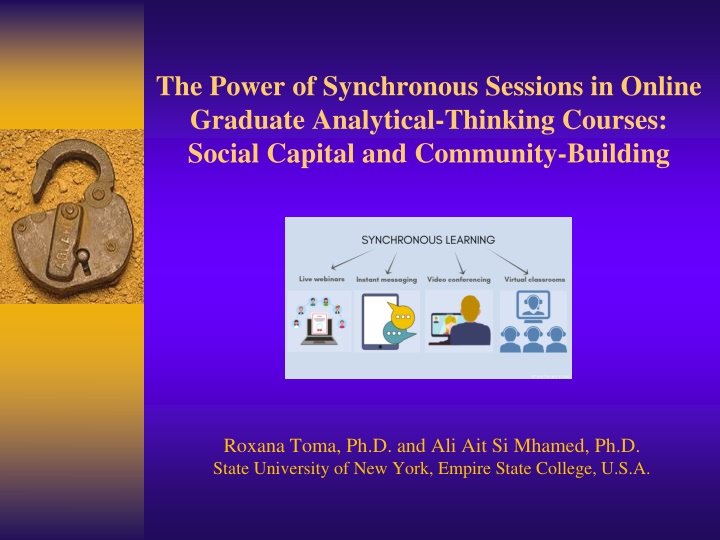
Empowering Online Graduate Courses through Synchronous Sessions
Explore the impact of synchronous sessions in online graduate analytical-thinking courses on building social capital and community. Learn how adding synchronous sessions can level educational attainment fields and enhance students' development in various fields. This proposal is grounded in Bourdieu's framework, highlighting the importance of habitus development and social connections in online learning environments.
Download Presentation

Please find below an Image/Link to download the presentation.
The content on the website is provided AS IS for your information and personal use only. It may not be sold, licensed, or shared on other websites without obtaining consent from the author. If you encounter any issues during the download, it is possible that the publisher has removed the file from their server.
You are allowed to download the files provided on this website for personal or commercial use, subject to the condition that they are used lawfully. All files are the property of their respective owners.
The content on the website is provided AS IS for your information and personal use only. It may not be sold, licensed, or shared on other websites without obtaining consent from the author.
E N D
Presentation Transcript
The Power of Synchronous Sessions in Online Graduate Analytical-Thinking Courses: Social Capital and Community-Building Roxana Toma, Ph.D. and Ali Ait Si Mhamed, Ph.D. State University of New York, Empire State College, U.S.A.
Introduction The field of distance education has already proved its validity and value (Xiao, 2018) and research indicates that there is no difference between distance education and face-to-face education (Russell, 1999). However, throughout the pandemic many have argued that with online classes (which are by and large asynchronous,) learning outcomes often disappoint, because virtual instruction runs counter to the most important assets at a major university: personal interaction with highly qualified experts personal interaction and community building with peers
This is Where We Come In We bring social capital theory and Bourdieu s work on the sociology of education in the often-misunderstood narrative of online learning, which is seen as both an isolated and deeply isolating experience. Our contribution is twofold. First, we introduce the idea of building social capital and community in an online environment between instructor and students on the one hand, and among students on the other. Second, we propose that we look at praxis informed, committed action, to address socially differentiated educational attainment (prior conditions like SES, race, affecting retention/graduation rates and time to degree completion,) which is perceived to be more pronounced in online learning.
Our Proposal Adding recurrent synchronous sessions to online teaching (that is otherwise asynchronous,) especially in graduate-level research, quantitative, and analytical subjects, will help in two ways: 1. level out the field of differentiated educational attainment that some students are prone to 2. create community and social capital, a hugely beneficial ingredient to students habitus development, and their implicit operation in their respective fields. To illustrate this, we use a qualitative design to analyze student perceptions of the benefits of adding synchronous sessions in five online courses (otherwise asynchronous) during 2020-2021.
Building on Bourdieus framework Habitus describes an individual s unique characteristics; their tastes, perceptions, or ways of responding and thinking. Learning involves developing the habitus that is required to successfully operate within a particular field. The more habitus is acquired, the better someone can proceed in these fields, and in a greater range of situations. The academic skills developed during higher education study, and the confidence in using them, represent forms of embodied cultural capital. These capacities and dispositions are not simply acquired by individuals, they are also caught up in other forms of capital that are brought about by the social networks and social connections generated through enrollment and engagement with the program (social capital).
Praxis Praxis: moving back and forth in a critical way between reflecting and acting on the world. Educational Praxis: morally informed and committed action that helps to shape social formations and conditions, implicitly affecting how one acquires their cultural and social capital and ultimately, how their habitus is developed and further refined.
Why this is Important Emotions play a major role in online learning (Cleveland-Innes & Campbell, 2012) and the online learning context is robust enough to allow for caring relations to emerge at even a deeper level than that experienced in face-to-face contexts (Velasquez, Graham, & Osguthorpe, 2013). If we can help instructors and students to build social capital and community online, we can help further dispel the myths and misconceptions about online education.
Social Presence Gap Teachers are to overcome the social presence gap to equalize the outcomes and modalities Unaccustomed learning is challenging and less social support in settings of online learning from peers (Bedenlier et al. 2020) Increased workload in online learning and less social presence (Aristovnik et al. 2020)
The Importance of Synchronous Sessions Designing online curricula that does not stop at content delivery and assigning tasks for assessment purposes, but that intentionally creates spaces for learners to learn together (social constructivism) and to reimagine digital forms of informal social spaces (sometimes called third places) for connections similar to playgrounds and cafeterias (Bali, 2020) helps build students social and cultural capital.
Advantages of Synchronous Teaching and Learning Synchronous learning brings instructors and learners to a real time environment Instant feedback and real-time responses to questions that may otherwise accumulate in the learner s mind if they receive a video in an asynchronous environment Synchronous teaching eases the process of cooperative learning Learners have the choice to prioritize their learning Synchronous learning, if it is well used, promotes clear communication among students and between the instructor and students. Immediate feedback Discussion in real-time allows for ideas to emerge quickly Gives opportunity to smooth discussion and identifies emergent questions Group discussion allows students to develop their presentation skills More dynamic form of learning
Synchronous Sessions are the Cornerstone of a Pedagogy of Care While the theme of care in education has become popularized during the pandemic, it is a crucial element in online learning that has always been needed, and that will continue to be essential long after COVID-19.
Synchronous Sessions Address Socially Differentiated Educational Attainment A key part of a pedagogy of care is listening to students and engaging in open and authentic dialogue - particularly marginalized and disadvantaged students who are struggling with the compounded effects of inequities that already exist in educational systems - and providing additional and stronger support to address these concerns and challenges. This, we argue, cannot be done without regular synchronous sessions, especially in the research and analytical subjects taught at the graduate level. Synchronous sessions also help incorporate learner diversity and agency into online learning processes, as well as an understanding of students skills, support and learning materials that empower, rather than reinforce existing inequalities. It works toward a mutually supportive framework that will carry our pedagogic work into a more equitable future.
Strategies Have a clear agenda for the lesson because you don t want a long time in front of the screen Be less redundant in delivering work Enjoy being a facilitator, not a dominant instructor Leave room for students to interact Bring some rules of organization to the course (e.g. raising hand, etc.) Encourage students to use chat to provide enough opportunity to everyone to participate
Contextual Background for this Study SUNY Empire State College Public university with campuses and learning hubs in different regions of New York State. Educates more than 16,000 students a year For most part, courses are developed and delivered using asynchronous online mode Individualized and independent pathway for learning
Course Delivery Courses are fully developed for students with clear instructions for formative and summative assessments. Independent approaches and methods of studying are developed by instructors to serve their students well
Still Learning communities are proven to be effective (Liu et al., 2020; Swan, 2010) Building synchronous learning to asynchronous methods has proven to be efficient (Swan, 2010) Hence, this study s focus on The Power of Synchronous Sessions in Distance Education: Building Community and Resilience in the Age of COVID-19.
Methodology A multiple case study approach to analyze online graduate-level courses spanning different student academic backgrounds from three masters programs (Social and Public Policy, Community and Economic Development, Work and Labor Policy) and one doctoral program (Doctorate in Higher Education Leadership and Change) where we introduced regular synchronous sessions. A narrative analysis of student perceptions that were drawn from course evaluations and discussion forums in five online courses (that were otherwise asynchronous,) taught between January 2020 and December 2021. Masters programs courses Doctoral program courses Research Methods Foundations of Doctoral Study Public Policy Analysis Principles of Higher Education Leadership Capstone Project
Methodology Contd We used unstructured interviews and asked students the following two open- ended questions: 1) What did you think about the recurrent synchronous sessions? 2) In your opinion, what was the best aspect of this course? Students who wished to do so, provided their responses in short written reflections and shared them with us. Some of the data also came from course evaluations, which included the second question, and were anonymous. Academic term Spring 2020 Summer 2020 Fall 2020 Spring 2021 Summer 2021 Fall 2021 Fall 2021 Level of study Number of students 32 20 48 74 27 49 14 Response rate Masters level Masters level Masters level Masters level Masters level Masters level Doctoral level 28.12% 25.0% 25.0% 31.08% 48.15% 36.73% 57.14%
Findings: Common Themes 1. High level of supportive learning and understanding of difficult material. 2. Social presence gap filling; provides students with an incredible sense of community and belonging; interactive and engaging environment; empowering students; connected to a pedagogy of care. 3. Helpful for students with learning disabilities; while we are not aware of the number of students with these disabilities in our courses, the data we collected relies on students self-identifying as such while mentioning this helpfulness. 4. Especially helpful for students who struggle more than others (adds a layer of support); our programs serve a large population of students who are on financial aid, which may suggest that many of our students are likely to be prone to socially differentiated/lower educational attainment. Our findings indicate that students who generally struggled more than others found these sessions the most helpful in their learning process and progress, because they added a layer of support to their independent, asynchronous learning.
Excerpts I wanted to thank you for the support over the past two semesters - you have been more supportive and responsive than any other professor and it is much appreciated. Truly - you re the only one who has offered the time for live classes and encouragement when, we as students, have been challenged and in need of that guidance with our education. The synchronous sessions of [day and time specified] are essential to our learning, our professional development, and our ability to build community and connection, not to just each other but also to the material and institution. And, it makes sense Research has demonstrated that the best predictor to being resilient, to overcome challenge is to surround yourself with community and connections that are grounded in trust, mutual respect, and support. The [day and time] sessions do this for the cohort of the Program. Having returned to the student role after [many years], this level of support is essential, especially during the first semester of the program. Special thanks to my colleagues and our faculty mentor for taking the time and spending the energy on creating and supporting this opportunity to keep us engaged.
Excerpts Much of great endeavors and worthwhile efforts, have their healthy, strong roots, in relationships built on mutual trust and support for each other. What makes the healthy yoke of enduring leadership model, is cultivating strong roots and enduring connections. I appreciate you recognizing this critical theme of our experience and allowing for the space in which it may grow. The asynchronous model of our program is what works best for many of us. But asynchronous can be lonely and isolating, and when going through a [name of the program] program you need support and companionship. The weekly optional synchronous meetings give us the opportunity to meet face to face and connect with our cohort and instructor. In a time where there is a lack of connection worldwide, these meetings allow us to develop relationships, feel supported and gain experience in a co-curricular setting. No matter how busy life gets, this one hour is something I look forward to each and every week!
Excerpts There is nothing that compares to a synchronous session when it comes to learning and collaborating with faculty and students in a course. It matters less if the session is in person or virtual, but more on the fact that it is synchronous and not asynchronous. The natural dynamic that occurs when two or more people are interacting live over the internet is not replicable in a videotaped, pre-recorded session. The ability to listen and react and pose questions during a synchronous session far strengthens the learning aspect because one gets an immediate response and the back and forth can actually flow the discussion in different ways, with the professor choosing the path forward in the discussion based on the audience, the areas in which the group wants to participate, and the connections made among the students on the spot. One learns from the next and so on, and the faculty member, either as a teacher or a moderator, can make the learning experience more practical and relevant to the class. I highly recommend synchronous sessions as part of an online course. Even if sessions don t focus on course content all the time, the synchronous session bonds the online class in a common experience and likely leads to better outcomes and retention for future terms.
Excerpts I cannot emphasize enough the importance your clear explanations in the live classes play in my comprehension of this material. The second review class was just as helpful and informative as the first one. I appreciate the level of care you demonstrate toward students. You promote learning while empowering the class. This is a rare talent in a professor, and a gift to students. Coming from an educator perspective [professor s name] is a really great teacher! I loved the live discussions - this was a refreshing change from the written discussions in [the learning management system] that other courses do - I wish all courses did this instead! This is by far the BEST class I have taken at [college name] yet. I thoroughly enjoyed [professor s name] teaching style and think the professor has nailed an effective format for asynchronous online learning. My favorite part was the live sessions the professor hosted reviewing the assignments and taking questions. Online school can feel isolating, and it was so good to get instant responses to questions, have something explained verbally, and hear from the other students in the course. It allowed me to realize that I was on the same track and that my fellow students had the same questions as I did.
Excerpts My personal favorite aspect of the course is the "flipped classroom" model. [Professor s name] posts slide shows and recorded lectures, then holds online group sessions where we discuss the concepts we have learned on our own. This is a fantastic learning format that I feel works best for me as an adult learner with some minor learning disabilities. This allows me to set my own pace while knowing my professor is available live at regular intervals for any questions or clarification. I really appreciated the live sessions you provided. Though I do prefer not taking courses in a physical classroom, listening to your explanations, and answers to questions, really helped me to understand the concepts more clearly. The video office hours reminded me of the value of live collective class discussion and the insight that can be achieved through verbal instruction. As someone with a learning disability who has always had to overcompensate to succeed academically, [professor s name] teaching style, clear and concise communication/organization and thoughtful manner during the live sessions have allowed me the opportunity to enjoy the learning process.
Conclusions Revitalized the discussion about benefits of synchronous sessions in online learning (that is otherwise asynchronous,) especially in graduate research and analytical courses (more difficult to teach online). Combination of synchronous/asynchronous seems to work better for adult learners, for students with learning disabilities, and for students who are prone to lower educational attainment, because of the added layer of support praxis Synchronous classes empower students and provide them with an effective way to build community and social capital, something that students claim it cannot be achieved online through asynchronous work only. These elements of social capital and community-building are intrinsic to students habitus development and how well they will operate in their respective fields. For students, synchronous classes especially during the pandemic, were strongly connected with a pedagogy of care
Thank you very much! Questions? Roxana Toma, Ph.D. roxana.toma@esc.edu Ali Ait Si Mhamed, Ph.D. ali.aitsimhamed@esc.edu


